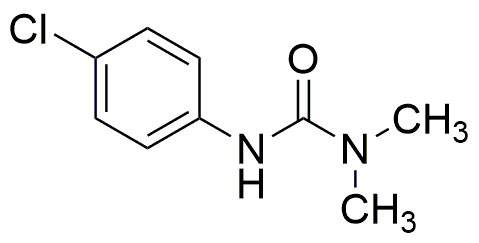3-(4-Chlorophenyl)-1,1-dimethylurea is widely utilized in research focused on:
- Agricultural Chemistry: This compound acts as a herbicide, effectively controlling weed growth in various crops, thus enhancing agricultural productivity.
- Pharmaceutical Development: It serves as a key intermediate in the synthesis of pharmaceuticals, particularly in the development of anti-inflammatory and analgesic drugs.
- Environmental Studies: Researchers use it to study the degradation of chemical compounds in soil and water, helping to assess environmental impact and safety.
- Analytical Chemistry: It is employed in analytical methods for detecting and quantifying pesticide residues, ensuring food safety and compliance with regulations.
- Biochemical Research: The compound is utilized in studies related to enzyme inhibition, providing insights into metabolic pathways and potential therapeutic targets.
General Information
Properties
Safety and Regulations
Applications
3-(4-Chlorophenyl)-1,1-dimethylurea is widely utilized in research focused on:
- Agricultural Chemistry: This compound acts as a herbicide, effectively controlling weed growth in various crops, thus enhancing agricultural productivity.
- Pharmaceutical Development: It serves as a key intermediate in the synthesis of pharmaceuticals, particularly in the development of anti-inflammatory and analgesic drugs.
- Environmental Studies: Researchers use it to study the degradation of chemical compounds in soil and water, helping to assess environmental impact and safety.
- Analytical Chemistry: It is employed in analytical methods for detecting and quantifying pesticide residues, ensuring food safety and compliance with regulations.
- Biochemical Research: The compound is utilized in studies related to enzyme inhibition, providing insights into metabolic pathways and potential therapeutic targets.
Documents
Safety Data Sheets (SDS)
The SDS provides comprehensive safety information on handling, storage, and disposal of the product.
Product Specification (PS)
The PS provides a comprehensive breakdown of the product’s properties, including chemical composition, physical state, purity, and storage requirements. It also details acceptable quality ranges and the product's intended applications.
Certificates of Analysis (COA)
Search for Certificates of Analysis (COA) by entering the products Lot Number. Lot and Batch Numbers can be found on a product’s label following the words ‘Lot’ or ‘Batch’.
*Catalog Number
*Lot Number
Certificates Of Origin (COO)
This COO confirms the country where the product was manufactured, and also details the materials and components used in it and whether it is derived from natural, synthetic, or other specific sources. This certificate may be required for customs, trade, and regulatory compliance.
*Catalog Number
*Lot Number
Safety Data Sheets (SDS)
The SDS provides comprehensive safety information on handling, storage, and disposal of the product.
DownloadProduct Specification (PS)
The PS provides a comprehensive breakdown of the product’s properties, including chemical composition, physical state, purity, and storage requirements. It also details acceptable quality ranges and the product's intended applications.
DownloadCertificates of Analysis (COA)
Search for Certificates of Analysis (COA) by entering the products Lot Number. Lot and Batch Numbers can be found on a product’s label following the words ‘Lot’ or ‘Batch’.
*Catalog Number
*Lot Number
Certificates Of Origin (COO)
This COO confirms the country where the product was manufactured, and also details the materials and components used in it and whether it is derived from natural, synthetic, or other specific sources. This certificate may be required for customs, trade, and regulatory compliance.


